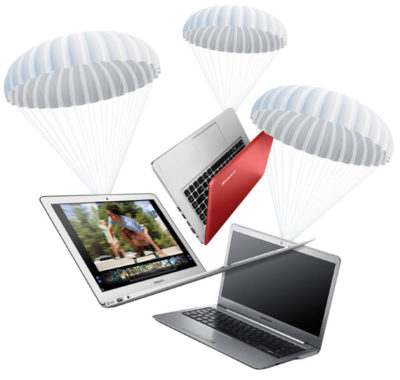Meet the Ultrabooks

Laptops today are undergoing a dramatic makeover. These slimmer, sleeker, portable PCs promise longer battery life, faster performance, and (yes!) less back and shoulder strain.
Any discussion of ultra-thins must start with Apple’s MacBook Air (apple.com/macbookair), the iconic, razor-thin portable that famously slides inside a manila envelope. The Air is both durable and light; and since it uses flash memory to store files rather than a spinning hard disk, it’s a lot quieter, too. The Air exemplifies Apple’s attention to detail. Its backlit keyboard, for instance, automatically illuminates in low-light conditions. The 11- and 13-inch models start at $1,000 and $1,200, respectively.
The MacBook Air’s popularity spurred Windows PC makers to create Air-like laptops called “Ultrabooks,” a term coined by chip-maker giant Intel. An Ultrabook shares many of the Air’s most desirable attributes: less than an inch thick; 3- to 4-pound weight; the ability to turn on instantly like a smartphone or tablet; and battery life of 5 to 9 hours. Top-tier laptop makers, including Acer, ASUS, Dell, HP, Lenovo, Samsung, Sony, and Toshiba, sell Ultrabooks today, and many more models are coming soon.
Most Ultrabooks lack a DVD drive, which isn’t a problem for most users. With the advent of streaming audio and video, as well as cloud services that back up your files online, discs are rapidly going the way of floppies.
“I think eventually all notebooks will become slim,” says Bob O’Donnell, computer analyst for IDC, a technology research firm. He predicts the average selling price for Ultrabooks will be around $800 by the end of 2012.
In fact, many Ultrabooks are already there. Lenovo’s stylish IdeaPad U310 ($800; lenovo.com) has a 13.3-inch display, weighs 3.75 pounds, and is available in a trio of fashion-forward colors, including Cherry Blossom, Aqua Blue, and Graphite Gray. The battery lasts up to 7 hours.
The Samsung Series 5 14.0” Ultra ($800; samsung.com) weighs less than 4 pounds and features a 14-inch display. This sleek notebook somehow manages to squeeze in a DVD drive, too.
The VIZIO Thin + Light ($900 to $1,250; vizio.com) has an aluminum frame and a clean, minimalist look that rivals (some might say copies) the MacBook Air’s sleek aesthetic. Available with a 14- or 15.6-inch screen, the Thin + Light weighs 3.4 or 4 pounds and runs 5.5 to 7 hours between charges, depending on the model.
The newest Ultrabooks add something most laptops don’t have: a touchscreen. Why? Because Microsoft’s Windows 8 operating system, which debuts this fall, is built to run on both PCs and touchscreen tablets. New laptops such as the Acer Aspire S7 let you navigate the screen in two ways: using traditional touchpad and keyboard commands or by tapping the screen as you would with a smartphone or tablet. It remains to be seen, however, if touch commands on a laptop make sense, particularly if it means holding your arm in an elevated position for hours on end.